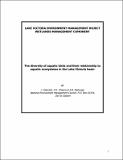The diversity of aquatic birds and their relationship to aquatic ecosystems in the Lake Victoria basin
Author
Date
2005Type
Reportviews
downloads
Metadata
Show full item recordxmlui.dri2xhtml.METS-1.0.item-citation
The diversity of aquatic birds and their relationship to aquatic ecosystems in the Lake Victoria basin BY J. Katondo, P.K. Chisara & S.B. Mahongo National Environment Management Council, P.O. Box 63154, Dar es Salaam
Abstract/
Lake Victoria basin harbours a variety of aquatic ecosystems mainly referred to as wetlands. These wetlands range from permanent swamps, open water bodies and river systems. The wetlands being a transition ecosystem between land and water are characterised by high diversity of flora and fauna. Some of these wetlands are important habitats for varied number of waterfowls. This chapter attempts to give a highlight on the diversity of Lake Victoria wetland birds, their relationship to aquatic ecosystems and their conservation strategy. Most of the information that is documented in this chapter originates from pilot study area as identified during the Lake Victoria Environmental Management Project (LVEMP) Activity Implementation. These study areas are centred at Simiyu and Rubana Riverine Wetland System and the Mwanza Gulf and the Kitaji Wetland System, which is situated in Musoma town. Birds can provide a lot of information with respect to measure of the health of the environment because of their sensitivity to changes in characteristics of the aquatic ecosystems. It is important first to carry out fieldwork to realize how various species interact with the ecosystem, discover their population dynamics of particular concern and assess the impact of environmental degradation, before finally determining steps which are required to enable the ecosystem to flourish with a full complements of species at sustainable manner. Birds have been used as indicators of pollution either through direct analysis of the food they take, or by monitoring the changes in species richness or abundances.Unlike the reptiles that are scarce or inconspicuous, birds are easily seen and many of the species move in great numbers. The status of most bird species is reasonably known and update of species conservation have been developed or are in the process of being developed, especially for the Lesser Flamingo.

